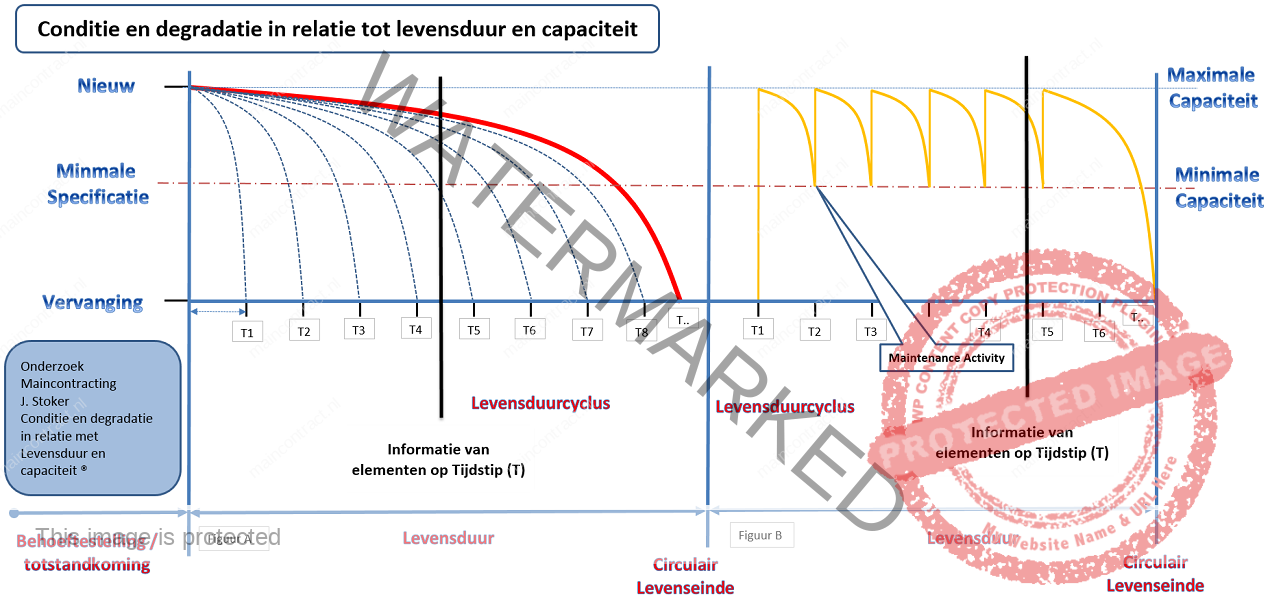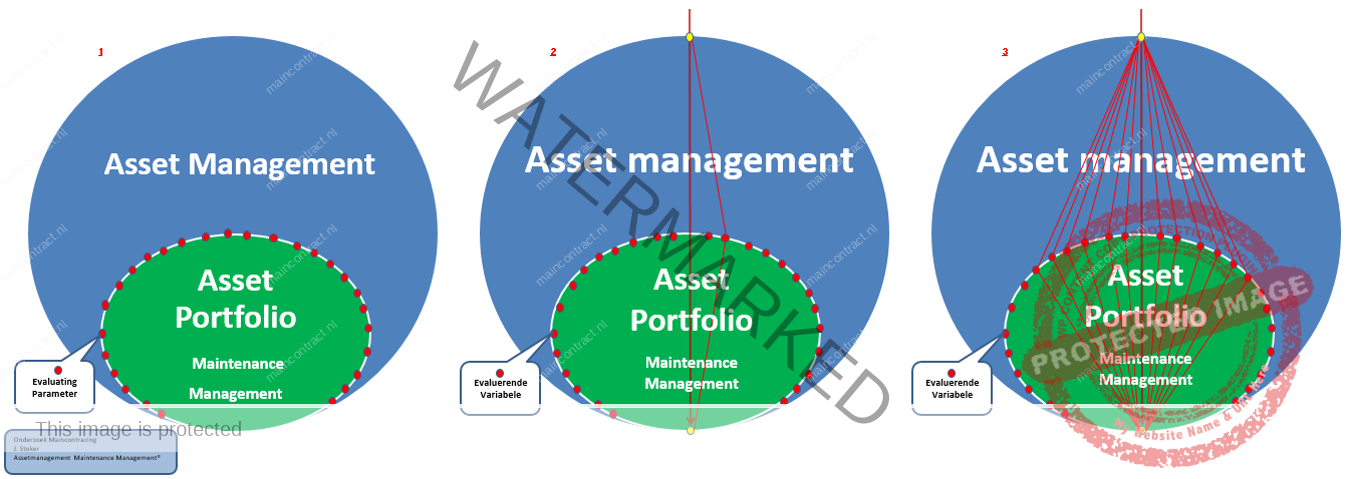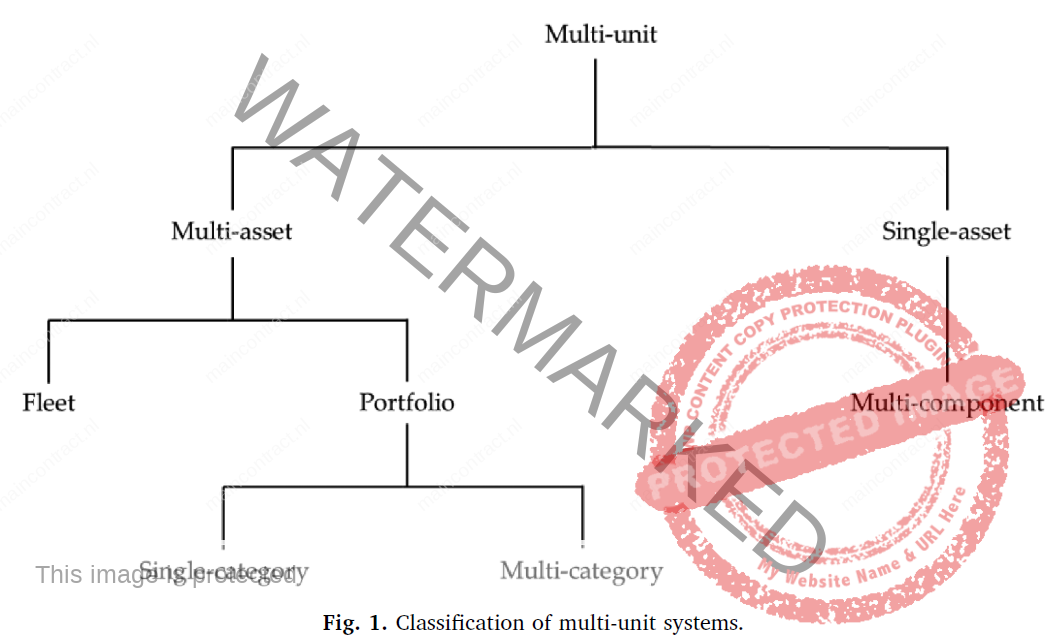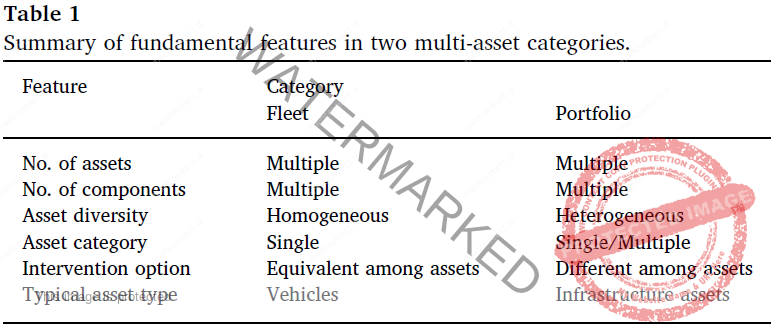Pagina Inhoud [Weergeven]
![]()
The research is focused on the role of Maintenance Management as one of the four fundamental basic principals of Asset Management as defined in the NEN-ISO 55000. The reason is that the ISO 55000 Maintenance Management regarded as one of the four fundamental pillars of Asset Management. Despite the fact that the standard defines a Asset in such a way that it could be anything, it gives no insight into the structures in which Assets are composed. The research aims to provide insight into this through from the inheritance the three types of element structures (Civil, Building and Industrial Process) adding to the paradigm used by the standard and connecting the policy to the smallest Asset component. This linkage is named “The Line Of Sight” and is based on the analogy with the ” Research Onion “. The following considering describes (shortened) this insight so that the degree of influence of failure by the smallest Asset Component definable and/or quantified and is part of a number of related topics. Derived of this consideration is the SAMP/AMP, the definition of the concept Maincontracting and other related topics and objectives of the research.
This article is close related with the article ‘The line of Sight: Deepening the subject”. Click here for the articleFull Width- Draft Version: 17 April 2019
- Updated 10 June 2019 (Version 1.0)
![]()
This article gives an overview of the literature on asset management for multi-unit systems with an emphasis on two multi-asset categories: fleet (a system of homogeneous assets) and portfolio (a system of heterogeneous assets). As asset systems become more complicated, researchers have employed different terms to refer to their specific problems. With an objective to facilitate readers in searching conducive studies to their interests, this paper establishes a novel classification scheme for multi-unit systems in accordance with essential features such as diversity of assets and intervention options.
Moreover, discerning differences in characteristics between
crosscomponent and cross-asset interactions, they select three types of potential multi-component dependencies (performance, stochastic, and resource) and extend their notions to be applicable to multi-asset systems. The investigation into these dependencies enables the identification of problems that could exist in real industrial settings but are yet to be determined in academia. Ultimately, the authors delve into modelling approaches adopted by previous researchers. This comprehensive information allows us to offer the insights into the current trends in multi-asset maintenance. The authors expecting that the output of this review paper will not only stress research gaps in multi-asset systems, but more importantly help systematise future studies on this aspect.
![]()
Author: Sanyang Petchrompo, Ajith Kumar Parlikad; Science DirectManagement Systems
1. Introduction
This focus has therefore led to the emergence of the term ‘multi-unit system’ in reliability engineering research. With various interactions among components and assets in a system, optimization modelling for maintenance has become immensely complicated.
Asset Management Systems: See The Line of Sight-Deepening the subject
On one hand, these intricate interactions require substantial computational resources to deal with operations and maintenance problems. On the other hand, these characteristics also open up opportunities for devising policies that, compared to individual optimization strategies, enhance the efficiency of the overall system. Over the past years, researchers have put forward innovative solution methods for different types of multi-unit systems. Although these studies have greatly contributed to the body of knowledge and benefited the industry, adopters are required to put strenuous efforts to search for models that are appropriate for their specific problems. This is because different researchers have employed different expressions to refer to their systems.
Previous overview articles have made impressive strides in facilitating literature search for readers by categorizing multi-unit systems according to their distinctive features. These classifications are generally based on types of dependence among members of a system. Dekker et al. [1] and Nicolai and Dekker [2] laid the foundations for the three main categories: economic, stochastic, and structural dependence. Structural dependence occurs when an intervention of a component requires that other components be intervened (either replaced or dismantled) at the same time. Stochastic dependence is referred to as failure interactions among components.
![]()
![]()
Economic dependence implies that a joint maintenance of several components either negatively or positively affects the overall expense. Recently, Olde Keizer et al. [3] established the concept of resource dependence in which components in a system share common resources such as budget or spare parts. The authors of the paper also extended the definition of structural dependence by further classifying this into technical and performance dependence. A system is considered technically dependent when intervention activities for certain components are restricted by those of other components; the negligence of this dependence inevitably results in an infeasible maintenance strategy. Performance dependence is applied when an intervention activity, deterioration, and failure of a component affects the performance of other components and the overall system. This dependence is also referred to as system configuration in the survey by Wang and Chen [4].
The absence of performance dependence may lead to a feasible policy, but the optimality is not guaranteed. It is evident that previous literature review papers including [1–7] emphasis on single-asset systems comprised of multiple components. However, to the best of our knowledge, a survey that compiles studies on systems of multiple assets has not been carried out. A need for multiasset models emerges as intervention strategies for systems of multiple components are not applicable to systems of multiple assets. Two representative aspects that distinguish a multi-asset system from multicomponent system are the indistinct asset configuration and the effect of the system reliability on multiple stakeholders. Since the confrontational relationship among components in a multi-component system (e.g. series and parallel) is clearly defined, each component produces a distinct effect on the system output. In contrast, a multi-asset system such as a fleet of vehicles does not require that all assets work collectively in one location. Thus, the contribution of a dysfunctional asset on the output of a multi-asset system cannot be directly measured.
Another distinctive characteristic of a multi-asset system pertains to diverse effects of system reliability on multiple stakeholders. This characteristic is opposed to that of a multi-component system of which the reliability chiefly affects the asset owner. A multi-asset system such as a portfolio of highway assets, which is large in scale as compared to a multi-component system, not only produces an output for the asset owner but also provides direct services to multiple users. Thus, it is a daunting task to choose an appropriate method for enhancing the reliability of the whole multi-asset system. Since the reliability of each asset could contribute differently to the system performance, traditional maintenance policies that consider each asset from a single dimension are not geared to supporting users to make well-informed decisions.
To overcome this limitation, later researchers and practitioners have provided broader views on operating and maintaining physical assets and established the field of asset management. The term asset management has been widely used since the International Organisation for Standardization (ISO) established its definition in ISO 55000 [8].
![]()
Click to expand
![]()
Asset management is defined as an integrated activity to realize value from systems of assets. Compared to traditional maintenance engineering, despite the similar aim to enhance the system reliability, asset management extends its focus beyond improving system safety and reducing cost to delivering performance benefits to organisations and their stakeholders [9,10]. Hence, in this integrated view, a decision on which asset and how it should be improved is determined by multiple output metrics, so that the utility of the system reliability is maximized.
The objective of this review paper is therefore to fill the literature gap by giving a review on comprehensive classes of multi-unit systems with an emphasis on multi-asset (fleet and portfolio) systems. To lay the foundations for our new classification, the authors compile different terms employed by previous researchers to refer to different multi-unit systems and examine their specific features (e.g. origin and usage, differences and similarities in intervention options, and asset diversity). Having identified patterned features of these terms, the authors classify multiunit systems into three categories: multi-component, fleet, and portfolio. To explore interactions among assets, the authors draw three types of potential dependencies – namely performance, stochastic, and resource – and extend these notions in order that they are conducive to all categories.
In addition, they collate studies that fall into these categories and identify possible dependencies that have not been examined in academia. Ultimately, for each multi-asset category, the authors scrutinize modelling approaches employed by previous scholars. Having delved into decision moments, objectives, types of assets, and techniques employed in these studies, the authors elaborate on the state-of-the-art and identify avenues for future research. The remainder of this review paper is organised as follows. Section 2 provides the definitions of related terms and establishes distinct classifications of multi-unit and multi-asset systems. In Section 3, they explore interactions among multiple assets within each of two multi-asset systems. Section 4 examines typical research problems in fleet and portfolio management and classifies these problems into seven decision classes. The authors also delve into methods for the enhancement of safety, reliability, and other performance measures of multi-asset systems in Section 5. Representative studies are also gathered and exhibited according to solution method, decision class, and asset category. In Section 6, the authors highlight the key gaps in the literature to issue guidelines on potential research areas. Lastly, conclusions are drawn in Section 7.
2. Classifications and definitions
In this section, the authors compile previous literature that bolsters the classification and definition of multi-unit systems. The authors review the terms that were employed by previous researchers to refer to these systems. Having filtered out irrelevant contexts, the authors consider patterns in these terms and establish distinct categories of multi-unit systems.
This section begins with the overview of the usage of the terms ‘multi-unit’ and ‘multi-asset’ systems. Subsequently, after providing our principal classification of these systems, the authors lay an emphasis on how the terms ‘fleet’ and ‘portfolio’ are adopted in asset management research. It is important to note that, in Section 2, the authors focusing on the elementary characteristics of the systems adopted by previous researchers in order to help us primarily define these systems.
![]()
Tags: Article, Asset Management, Assetmanagment, Components, Maintenance, Maintenance Management, Risk

















